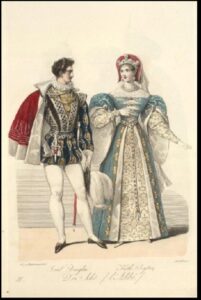Home University of Edinburgh Library Essentials
December 15, 2025
Balls, Bridgerton and Betrothals: Walter Scott Meets High Society
Posted on July 29, 2021 | in Walter Scott 250 | by lbeattie“The gentlemen, according to the fashion of the times, indulged, for the most part, in deep draughts of the richest wines, while the ladies, prepared for the ball which always closed a bridal entertainment, impatiently expected their arrival in the state gallery. At length the social party broke up at a late hour, and the gentlemen crowded into the saloon, where, enlivened by wine and the joyful occasion, they laid aside their swords and handed their impatient partners to the floor.” – Walter Scott, The Bride of Lammermoor.
The bewitching world of Netflix’s hit show Bridgerton has overtaken international pop culture this year. For the first since the release of Joe Wright’s Pride and Prejudice in (2005), regency fashion, manners and entertainments are, once again, at the forefront of our public consciousness. When considering this upheaval in popular culture, it is worth revisiting this arena and considering what it means for both our understanding and our study of Walter Scott.
When thinking of Walter Scott, images of battles or lengthy historical novels may come to mind. However, Scott was, like any Regency man, well-acquainted with the subject of balls and the necessity of social decorum. Although set in the early 18th century, Scott’s work The Bride of Lammermoor (1819) deals intimately with issues of contemporary romance and the pitfalls that could arise from this. The novel tells the tragic story of the doomed romance between Lucy Ashton and her familial enemy Edgar Ravenswood. Throughout the intriguing, and largely tragic, narrative, we are given insight into the courting rituals and expectations of the early 19th century.
Scott himself had lengthy understandings of romance. ‘In his “Essay on Romance” (1824), Scott defines Romance as “a fictitious narrative in prose or verse; the interest of which turns upon marvellous and uncommon incidents.”’[1] Scott had an awareness of romance, balls and the business of courtship and was clear to outline this within the essay. As much as The Bride of Lammermoor exists as an historical novel in its own right, it is hard not to read the tragic love story as a kind of social commentary. This commentary recognises the risks that arose in courtship, when lovers made themselves vulnerable. It also, just like Bridgerton, shows us the importance of family when making decisions about marriage.
Scott’s understandings of romance may have also been impacted by his own turbulent love life. His story of marriage to Charlotte Scott, née Carpenter, could have inspired its own spin-off series. The couple met whilst riding and Scott proposed after just three weeks! She herself was subject to criticism and scrutiny. Scott’s family feared that she was a Catholic and initially objected to the match. However, after much scrutiny and investigation, she and Scott remained happily married for three decades. Scott’s life, like his books, reflected much of the turmoil that these 19thcentury matches could invite. Just as Lucy Ashton’s family objected to a match with Edgar Ravenswood, Scott’s family objected to his own with Charlotte. Thankfully, for both Scott and Charlotte, their union ended far more happily than Scott’s fictional creations.
Thus, the world of Bridgerton is not so far from Scott’s own work as one might initially believe. Whilst it is true that Scott’s repertoire is largely historical novels, he did also invite romance and society commentary in his works. Likewise, just as in the turbulent world of Bridgerton, Scott is quick to illustrate both the benefits and foibles of this society: from the dullness of balls to the spark and potential of young love.
This blog has been published in celebration of the university’s new Walter Scott 250 Exhibition, which celebrates the famed author’s relationship with contemporary and historical revolution.
Works Cited
Hook, Andrew D. “The Bride of Lammermoor: A Reexamination.” Nineteenth-Century Fiction 22, no. 2 (1967): 111-26.
Walter Scott Digital Archive, Edinburgh University Library. “Williamina, Charlotte and Marriage”, available at. http://www.walterscott.lib.ed.ac.uk/biography/marriage.html. Accessed July 6, 2021.
Scott, Walter. The Bride of Lammermoor (1819).
[1] Hook, Andrew D. “The Bride of Lammermoor: A Reexamination.” Nineteenth-Century Fiction 22, no. 2 (1967): 112.
Collections
 Hill and Adamson Collection: an insight into Edinburgh’s past
My name is Phoebe Kirkland, I am an MSc East Asian Studies student, and for...
Hill and Adamson Collection: an insight into Edinburgh’s past
My name is Phoebe Kirkland, I am an MSc East Asian Studies student, and for...
 Cataloguing the private papers of Archibald Hunter Campbell: A Journey Through Correspondence
My name is Pauline Vincent, I am a student in my last year of a...
Cataloguing the private papers of Archibald Hunter Campbell: A Journey Through Correspondence
My name is Pauline Vincent, I am a student in my last year of a...
Projects
 Cataloguing the private papers of Archibald Hunter Campbell: A Journey Through Correspondence
My name is Pauline Vincent, I am a student in my last year of a...
Cataloguing the private papers of Archibald Hunter Campbell: A Journey Through Correspondence
My name is Pauline Vincent, I am a student in my last year of a...
 Archival Provenance Research Project: Lishan’s Experience
Presentation My name is Lishan Zou, I am a fourth year History and Politics student....
Archival Provenance Research Project: Lishan’s Experience
Presentation My name is Lishan Zou, I am a fourth year History and Politics student....


